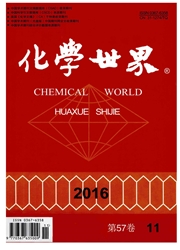

 中文摘要:
中文摘要:
采用后合成法将3-氨丙基三甲氧基硅烷嫁接在纯硅介孔分子筛KIT-1的孔道内外表面,制备出含氨丙基基团的介孔分子筛样品NH2-KIT-1,并用于苯甲醛和丙二酸二乙酯Knoevenagel缩合反应。利用傅里叶变换-红外光谱(FT IR)、X射线粉末衍射(XRD)、N2吸附-脱附和酸碱滴定等方法对样品的结构和表面碱含量进行了表征与测定。结果表明:氨丙基已成功嫁接在分子筛KIT-1表面,样品NH2-KIT-1仍保持了基体KIT-1的介孔结构和较高的比表面积、较大的孔容与孔径。表面碱含量为1.105 mmol/g样品(即30%NH2-KIT-1)在苯甲醛和丙二酸二乙酯Knoevenagel缩合反应中表现的催化活性最好,140℃反应12h,苯甲醛的转化率为66.5%,重复使用4次后,苯甲醛转化率下降到46.9%,表面碱含量下降到0.870mmol/g。催化剂活性下降的原因可能是分子筛表面活性基团-(CH2)3-NH2脱落造成的。
 英文摘要:
英文摘要:
Aminopropyl functionalized NH2-KIT-1 catalysts for Knoevenagel condensation of benzaldehyde and diethylmalonate were prepared by surface modification of pure silicon mesoporous molecular sieve KIT-1 with 3-aminopropyltrimethoxy silane,and characterized by powder X-ray diffraction(XRD),Fourier Transform infrared spectroscopy(FT IR),N2 adsorption-desorption isotherm and chemical titration.Experimental results showed that the original mesoporous structure of the samples remained after modification.The FT IR demonstrated that the organic group(-Si-(CH2)3-NH2) had successfully grafted onto the inter-surface of KIT-1,but the grafted samples showed a lower BET surface area,pore volume and smaller pore size.30% NH2-KIT-1(1.105 mmol/g of alkali sites) showed superior catalytic activity in Knoevenagel condensation of benzaldehyde and diethylmalonate.The conversion of benzaldehyde on the catalyst was 66.5% for the first time and 46.9% after four runs at 140 ℃ following the drop of surface alkali content down to 0.870 mmol/g.The reason for the decline of catalytic activity is the decrease of the surface activity group-(CH2) 3-NH2 on the sample.
 同期刊论文项目
同期刊论文项目
 同项目期刊论文
同项目期刊论文
 期刊信息
期刊信息
